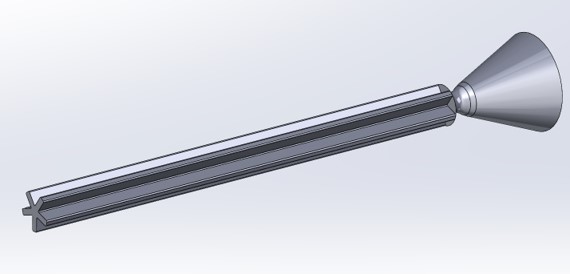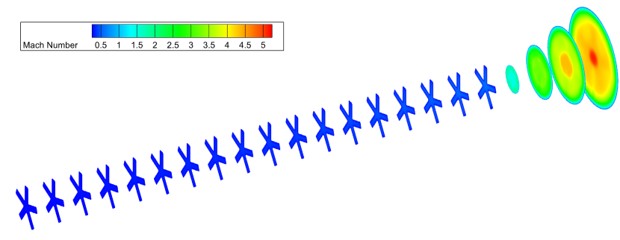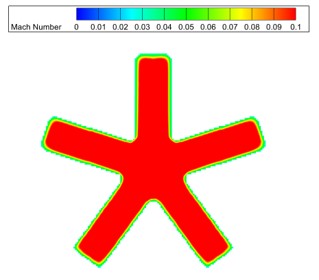Numerical Analysis of Internal Flow Fields in Aerospace Propulsion Systems Using the Building-Cube Method
JAXA Supercomputer System Annual Report February 2024-January 2025
Report Number: R24EACA52
Subject Category: JSS Inter-University Research
- Responsible Representative: Shinichiro Ogawa, Assistant professor, Osaka Metropolitan University
- Contact Information: Shinichiro Ogawa, Assistant professor, Osaka Metropolitan University
- Members: Shinichiro Ogawa, Loup Mael Agulles, Daisuke Sasaki, Shoya Yoshinaga, Keishiro Yoshida
Abstract
In this study, to elucidate the internal flow field of a solid rocket motor, a numerical analysis was conducted using the Building-Cube Method (BCM), which applies the immersed boundary method to a solid rocket motor model with a star-shaped grain configuration. BCM facilitates high-accuracy spatial schemes and reduces computational costs in large-scale simulations. The analysis model targeted a solid rocket motor known as CASTOR-I, which features a pentagram-shaped cross section. The objective of this study is to validate the wall injection model, which simulates the flow field generated from the propellant, by applying it to a practical solid rocket motor with a star-shaped grain configuration."
Reference URL
N/A
Reasons and benefits of using JAXA Supercomputer System
In this study, three-dimensional numerical analysis was conducted on the complex geometry inside an aerospace engine, which involves a high computational load. Therefore, the JAXA supercomputer, which enables large-scale numerical analysis in a short time, was used.
Achievements of the Year
In this study, a three-dimensional numerical analysis was conducted on a solid rocket motor model with a pentagram-shaped cross section, known as CASTOR-I, as shown in Fig. 1. The inflow conditions for the wall surface where the wall injection model was applied were as follows: mass flow rate of 105 kg/s, total temperature of 2900 K, and total pressure of 3.792 × 106Pa. The results of this analysis are presented in Figs. 2 and 3. The results confirmed that the flow was injected from the wall of the star-shaped grain where the wall injection model was applied. Furthermore, the injected flow accelerated as it exited the nozzle. Therefore, the numerical simulation was successfully conducted under wall injection conditions, even for a solid rocket motor model with a star-shaped grain configuration. In the following fiscal year, further improvements in computational accuracy and an investigation of the effects of propellant combustion-induced wall regression on the flow field are planned.
Publications
- Peer-reviewed papers
[1] Shinichiro Ogawa and Daisuke Sasaki, "Development of a Radial Injection Flow Model of a Cylinder Simulating a Solid Rocket Motor Geometry using the Building-Cube Mthod," Transactions of the Japan Society for Aeronautical and Space Sciences, 67 (2024), pp. 307-317.
- Oral Presentations
[1] Shinichiro Ogawa, Loup Mael Agulles, Daisuke Sasaki and Shoya Yoshinaga, "Evaluation of the wall regression on internal flow field of star grain solid rocket motor using numerical analysis," The 8th International Symposium on Enegetic Materials and their Applications," November 2024.
[2] Shinichiro Ogawa, Loup Mael Agulles, Daisuke Sasaki, Shoya Yoshinaga and Keishiro Yoshida, "Current Status and Challenges in Internal Flow Field Analysis Using the Building-Cube Method with the IB Method," 42nd Aerospace Numerical Simulation Technology Symposium, July 2024.
[3] Shinichiro Ogawa and Daisuke Sasaki, "Numerical Analysis of Fuel Injection in Supersonic Flow Using Building-Cube Method," 42nd Aerospace Numerical Simulation Technology Symposium, July 2024.
Usage of JSS
Computational Information
- Process Parallelization Methods: N/A
- Thread Parallelization Methods: OpenMP
- Number of Processes: 1
- Elapsed Time per Case: 100 Hour(s)
JSS3 Resources Used
Fraction of Usage in Total Resources*1(%): 0.04
Details
Please refer to System Configuration of JSS3 for the system configuration and major specifications of JSS3.
| System Name | CPU Resources Used(Core x Hours) | Fraction of Usage*2(%) |
|---|---|---|
| TOKI-SORA | 0.00 | 0.00 |
| TOKI-ST | 9702.83 | 0.01 |
| TOKI-GP | 0.00 | 0.00 |
| TOKI-XM | 0.00 | 0.00 |
| TOKI-LM | 138002.86 | 9.96 |
| TOKI-TST | 0.00 | 0.00 |
| TOKI-TGP | 0.00 | 0.00 |
| TOKI-TLM | 0.00 | 0.00 |
| File System Name | Storage Assigned(GiB) | Fraction of Usage*2(%) |
|---|---|---|
| /home | 0.00 | 0.00 |
| /data and /data2 | 91140.00 | 0.44 |
| /ssd | 0.00 | 0.00 |
| Archiver Name | Storage Used(TiB) | Fraction of Usage*2(%) |
|---|---|---|
| J-SPACE | 0.00 | 0.00 |
*1: Fraction of Usage in Total Resources: Weighted average of three resource types (Computing, File System, and Archiver).
*2: Fraction of Usage:Percentage of usage relative to each resource used in one year.
ISV Software Licenses Used
| ISV Software Licenses Used(Hours) | Fraction of Usage*2(%) | |
|---|---|---|
| ISV Software Licenses(Total) | 0.53 | 0.00 |
*2: Fraction of Usage:Percentage of usage relative to each resource used in one year.
JAXA Supercomputer System Annual Report February 2024-January 2025





